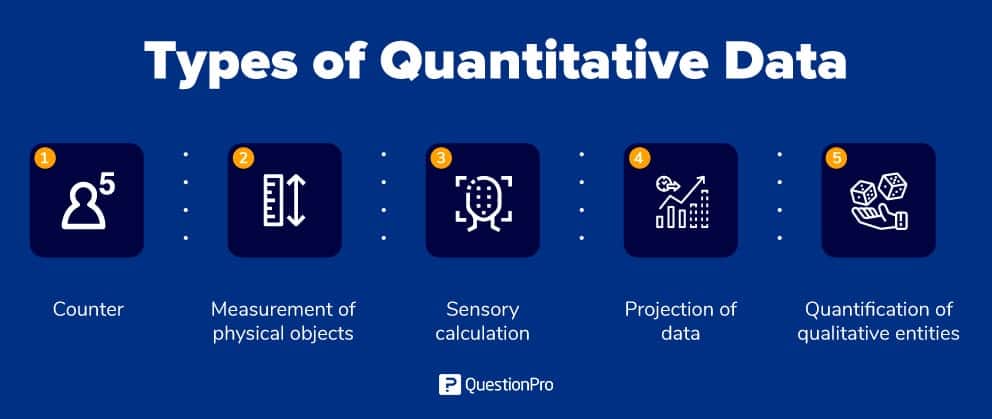
In 2025, businesses that harness the power of data-driven decision-making are the ones poised to thrive. Among the myriad types of data available, quantitative data stands out as a critical enabler for smart, strategic, and sustainable business decisions. It forms the backbone of analytics, enabling companies to measure performance, understand trends, and predict outcomes with precision.
This article dives deep into the role of quantitative data in shaping smarter business strategies, how it has evolved in today’s context, and why it’s indispensable for companies navigating the complexities of 2025.
What is Quantitative Data? Why Does It Matter?

Source: QuestionPro
Quantitative data refers to information that can be measured, quantified, and expressed numerically. Unlike qualitative data, which captures subjective observations and opinions, quantitative data provides hard, actionable facts. These measurable insights enable businesses to analyze performance metrics, test hypotheses, and build predictive models.
Examples of Quantitative Data in Business:
- Monthly sales revenue.
- Customer churn rates.
- Website traffic and engagement metrics.
- Inventory turnover ratios.
- Marketing ROI and ad conversion rates.
Quantitative data’s objective nature makes it invaluable for businesses striving for accuracy, efficiency, and evidence-based decisions in a competitive landscape.
The Rising Importance of Quantitative Data in 2025
As the volume of global data grows exponentially, businesses face the dual challenge of managing vast information while deriving actionable insights. In this era, quantitative data offers clarity amidst complexity.
1. Data-Driven Decision-Making
Quantitative data is the foundation of data-driven decision-making. By analyzing numerical metrics, businesses can:
- Predict future trends through statistical models.
- Optimize operations based on performance data.
- Identify growth opportunities by analyzing customer purchasing patterns.
2. The Growth of AI and Predictive Analytics
Artificial Intelligence (AI) and predictive analytics thrive on quantitative data. In 2025, businesses increasingly use AI to process vast datasets, identify patterns, and forecast outcomes. Whether it’s predicting inventory needs or personalizing customer experiences, quantitative data powers these capabilities.
3. Evolving Consumer Expectations
Customers now expect hyper-personalized experiences. By analyzing quantitative data such as purchase histories, engagement metrics, and feedback scores, businesses can tailor offerings that resonate with individual preferences.
How Quantitative Data Enables Smart Business Decisions?
1. Performance Measurement
Quantitative data helps businesses measure progress against goals. Metrics like revenue growth, market share, and cost savings provide a clear picture of success or areas requiring improvement.
For instance, a SaaS company monitoring user acquisition rates can pinpoint which marketing channels deliver the highest ROI, ensuring better allocation of resources.
2. Identifying Market Trends
By analyzing large datasets, businesses can uncover emerging trends before competitors. For example, an e-commerce retailer tracking product category sales can identify rising demand for eco-friendly goods and adapt its inventory strategy accordingly.
3. Risk Mitigation
Quantitative data empowers companies to assess risks through predictive modeling. Whether it’s forecasting financial performance or assessing supply chain disruptions, quantitative metrics help mitigate uncertainties with confidence.
4. Enhancing Customer Retention
Tracking quantitative metrics like Net Promoter Scores (NPS), customer lifetime value (CLV), and churn rates enables businesses to gauge satisfaction and loyalty. These insights inform strategies for improving customer retention.
5. Optimizing Operations
Operational efficiency is driven by quantitative data. Metrics such as production lead times, labor productivity rates, and defect percentages help streamline workflows, reduce waste, and maximize profitability.
Overcoming Challenges in Leveraging Quantitative Data
Despite its immense potential, using quantitative data effectively comes with challenges:
1. Data Overload
Businesses often collect massive volumes of data, making it difficult to filter relevant metrics. A focused approach to tracking key performance indicators (KPIs) ensures actionable insights.
2. Data Quality Issues
Incomplete, inaccurate, or inconsistent data can undermine analysis. Ensuring data quality through robust collection methods and regular audits is crucial.
3. Contextual Interpretation
Quantitative data tells “what” happened but not “why.” Combining quantitative insights with qualitative analysis provides a fuller picture.
4. Skill Gaps in Data Analysis
Interpreting quantitative data requires expertise in analytics and statistical methods. Investing in upskilling or partnering with data service providers can bridge this gap.
Why Quantitative Data is Key for Decision Makers?
For businesses operating at the bottom of the funnel – where conversions, retention, and profitability take precedence- quantitative data is a game-changer.
- Precise Targeting: By analyzing conversion rates, click-through rates (CTR), and cart abandonment metrics, businesses can refine their strategies for maximum impact.
- Improved Retention: Metrics like repeat purchase rates and upsell conversions reveal opportunities to strengthen customer relationships.
- Revenue Growth: Quantitative insights help identify high-performing products and services, enabling businesses to allocate resources effectively for sustained growth.
Best Practices for Leveraging Quantitative Data
- Focus on Relevant Metrics: Identify KPIs that align with your business goals.
- Invest in Analytics Tools: Use advanced analytics platforms to process and visualize data effectively.
- Ensure Data Accuracy: Validate data sources and clean datasets regularly.
- Integrate Data Across Functions: Combine data from marketing, sales, and operations for holistic insights.
- Embrace Predictive Analytics: Use historical data to model future outcomes and stay ahead of trends.
Conclusion
As businesses navigate the challenges and opportunities of 2025, quantitative data remains a cornerstone of smart decision-making. Its ability to provide objective, measurable insights empowers companies to optimize performance, anticipate market changes, and deliver unparalleled value to customers.
At PromptCloud, we specialize in helping businesses unlock the power of data with customized solutions for web scraping, data extraction, and analysis. Whether you’re tracking KPIs, analyzing trends, or driving efficiency, our expertise ensures you’re equipped to succeed in a data-driven world.Ready to transform your business with quantitative data?Contact us today to discover how PromptCloud can help you harness the power of data for smarter decisions.



















